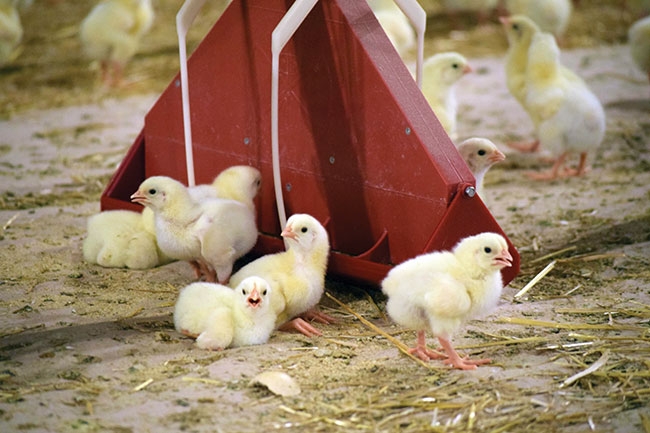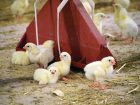
A new era of antibiotics use
By Treena Hein
Features Bird Management Production Animal Welfare annex Antimicrobial use Broiler production Canada Livestock medication Livestock Production Nutrition Poultry Production Production SustainabilityProducers prepare for big changes on the horizon.
 The relationships between vets, producers and feed mills will be important under new regulations that come into effect this year since most antimicrobials are administered in feed. Photo: Clark Ag Systems
The relationships between vets, producers and feed mills will be important under new regulations that come into effect this year since most antimicrobials are administered in feed. Photo: Clark Ag SystemsBy the end of 2018, Canadian chicken farming will reach two significant milestones related to the use of antibiotics.
By Dec. 1, 2018, there will be increased veterinary oversight of antibiotics, aligning regulations of Canada’s livestock and poultry industry with those in other developed countries as well as those of the World Health Organization. In addition, all Canadian broiler producers will eliminate the use of Category II antibiotics (medically-important for human health) by the end of the year for health and growth promotion and disease prevention, following the successful elimination of Category I antibiotics. The elimination of Category II antibiotics is mandatory, and will be ensured through audits relating to Farm and Food Safety Programs in each province. Preventative use of Category III antibiotics will be assessed in 2019 with the goal of eliminating them by the end of 2020.
To gain insight into what these two developments mean for chicken farmers, we checked in with several broiler industry stakeholders.
Increased veterinary oversight
Increased veterinary oversight of antibiotics means that prescriptions will be required for about 340 antimicrobial products that have been previously sold over the counter.
Antibiotics currently used in poultry that will soon require a prescription include: Chlortetracycline, Lincomycin, Oxytetracycline, Penicillin, Tylosin and Virginiamycin.
“The necessity of prescriptions for these antibiotics will require existence of a veterinary-client-patient-relationship, or VCPR, between a veterinarian and his or her poultry producer client,” notes Jean Szkotnicki, president of the Canadian Animal Health Institute, the non-profit trade association for developers, manufacturers and distributors of animal pharmaceuticals, biologics, feed additives and pesticides. “The VCPR means vets will have to know the management practices of their producers, the nature of the birds in production and be committed to providing ongoing service to ensure bird health and welfare. Producers will in-turn have to work closely with their vets.”
Szkotnicki says relationships between vets, producers and feed mills will also be important since approximately 75 per cent of the antimicrobials given to animals is administered in the feed.
Steve Leech, manager of food safety and animal health at Chicken Farmers of Canada (CFC), notes that his organization has been working with Health Canada for years on the issues surrounding increased veterinary oversight, from who can dispense which antibiotics to where and how antibiotics will be available for producers across the country.
“We have to make sure our members can access a veterinarian’s services and access antibiotics when needed to treat disease,” he explains. “We’ve done our best to identify hurdles on these fronts and work through them ahead of time, but it’s hard to say if there will be any that we have not identified.”
In terms of ensuring access to veterinary services for every producer in Canada, Leech says the use of remote diagnosis services already in place may expand – options like web-based sharing of pictures and video and remote analysis of lab samples collected by producers.
Elimination of Category II
According to CFC, Canadian chicken producers are on track to meet the goal of eliminating preventative use of Category II antibiotics by the end of the year, but the organization does stress that all members of the industry, including staff in various governmental departments, are going to need to work together to ensure the goal is reached. Leech characterizes the elimination of the preventative use of antibiotics as a fundamental change to the sector, one that involves close examination of management practices and quality assurance factors from broiler breeders to the hatchery to broiler farms.
In terms of making this transition easier for broiler producers, some suggestions are provided by Dr. Babak Sanei, manager of veterinary services for poultry and medicated feed additives at pharmaceutical firm Zoetis.
Given that preventative use of Category III antibiotics ends at the end of 2020, broiler producers will not be able to use products such as Bacitracin for prevention of Necrotic Enteritis (NE).
“This leaves producers with only one product, Avilamycin, for prevention of NE in-feed,” he says. “My concern is that industry will keep using this product, flock-after-flock, and gradually we will potentially see reduction in efficiency.”
Sanei, therefore, suggests a transitional period post-2020, where producers are allowed to use Bacitracin just within the most critical period of broiler’s life cycle, from 15-to-30 days.
“This is because peak of Eimeria Maxima happens usually between 22-to-30 days and sub-clinical coccidiosis infection can also happen during this phase (with coccidiosis being the most important predisposing factor for NE in broilers),” he says.
“Under field conditions, in most cases clinical or subclinical cases of E. Maxima infection predisposes for NE during the fourth week of life. [Use of Bacitracin during] this transitional period…doesn’t push the industry to use Avilamycin on a continuous basis. It will also provide more time to identify other alternative products with some antimicrobial effect.”
If this suggestion is not workable, Sanei strongly suggests that CFC allow producers to use bacitracin methylene disalicylate (BMD) under veterinary supervision on broiler farms that suffer from recurrent cases of NE. “This is a modification from current policy where you need to diagnose NE first and then start treatment,” he explains.
Sanei also suggests more field trials to identify alternatives to antibiotic products that have shown anticoccidial activity and can a have synergistic effect when used in conjunction with currently-available Coccidiostats.
“This needs direct involvement of feed nutritionists and veterinarians,” he says. “There are many products in this category, but not much field data is available to demonstrate their synergy with Coccidiostats, such as ionophores. This is important, as we need to improve our coccidiosis control strategies at the farm level.”
The biggest challenge for broiler producers going forward, in Sanei’s view, will be gut health issues, mainly due to the mode of action of in-feed antibiotics.
“Although their main mode of action is control of NE, they also have anti-inflammatory effect and can maintain better gut microflora,” he says. “I think we can minimize the impact through proper coccidiosis strategies, proper bird husbandry and diagnosis of subclinical gut health diseases such as NE as soon as possible. I believe post-2020, with full implementation of the policy, the main differentiating factor in whether a farm or given flock experiences NE or in general, gut health issues, is how effective the feed companies and producers can implement effective coccidiosis control programs.”
“Today, if a coccidiosis control program is not ideal,” Sanei continues, “it is still going to partially work, as there are in-feed antibiotics such as Bacitracin that cover the shortfall…However, after 2020, there is going to be only product that can be used, and hence more pressure on coccidiosis control programs. The feed companies need to optimize and rotate Coccidiostats to avoid development of resistance or losing efficacy of those products.”
In the view of Lisa Hodgins, a monogastric nutritionist at feed firm New Life Mills, the overall impact of preventative use of Category II antibiotics on producers will be small. She notes that in addition to high-quality standard ingredients, alternative ingredients such as essential oils, probiotics, prebiotics, enzymes and so on will continue to be utilized in feed programs as an aid in maintaining overall good gut health. She believes that as things move ahead, producers should continue to focus on good brooding strategies, water management and work with their veterinarians, hatchery, feed companies and nutritionists.
“There will never be one additive or one program that will be the ‘hero’ when it comes to raising birds without the preventative use of antimicrobials important to human medicine,” she notes. “As a nutritionist, I do believe that alternative ingredients, ingredient selection and quality are a small piece of the puzzle. However, there are so many factors involved. Disease pressure, brooding, management, water quality, biosecurity and sanitation are also very important.”
For his part, Nova Scotian broiler producer Nick de Graaf believes his industry has made great strides in reduction of antibiotic use. “I’m fully aware that the Category II shift is not going to be easy for either me or my fellow farmers, but I do think it’s in the best interest of my sector and it helps us make sure that we’re being responsible,” the producer says.
De Graaf foresees increased costs, specifically because of greater vet involvement, but assumes, “the impacts will vary, and that for my flocks, it will vary cycle-by-cycle and year-to-year, depending on the health of the flocks.”
Leech encourages poultry industry members to take the time to educate consumers about reduced use of antibiotics.
“It’s an important challenge facing the poultry industry and other livestock producers at this point,” he says. “We need consumers to know that our approach is a reasonable, science-based approach. Chicken farmers, veterinarians and all value-chain members need to communicate that the industry is being proactive and that farmers are engaged when it comes to responsible antibiotic use. It’s a very significant step and we should be sharing news of it widely.”
Essential takeaways
- By the end of 2018, Canadian chicken farming will hit two significant milestones related to the use of antibiotics –
- By Dec. 1, there will be increased veterinary oversight of many antibiotics, and all broiler producers will eliminate the use of Category II antibiotics by the end of the year for health and growth promotion and disease prevention.
- Preventative use of Category III antibiotics ends at the end of 2020.
- Relationships between feed mills, vets and producers will be even more vital.
- Chicken Farmers of Canada has been working with Health Canada for years on issues surrounding increased veterinary oversight.
- Producers are expected to experience higher costs.
- In addition to high-quality standard ingredients, alternative ingredients such as essential oils, probiotics, prebiotics and enzymes will continue to aid in maintaining good broiler gut health.
Print this page

